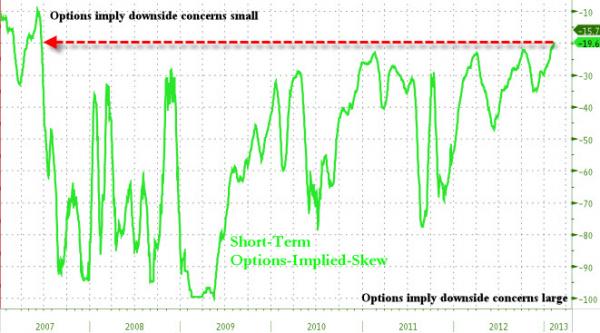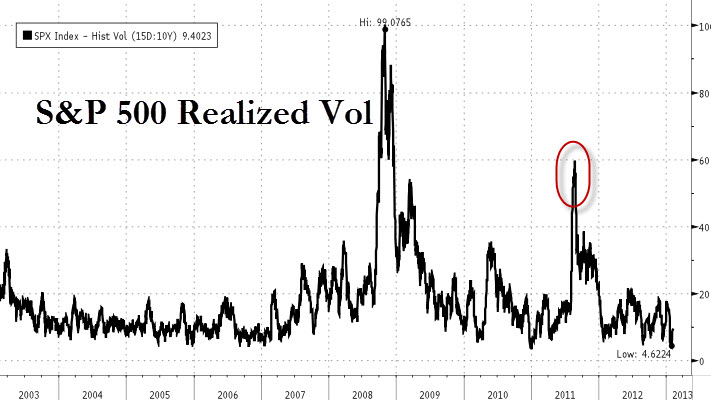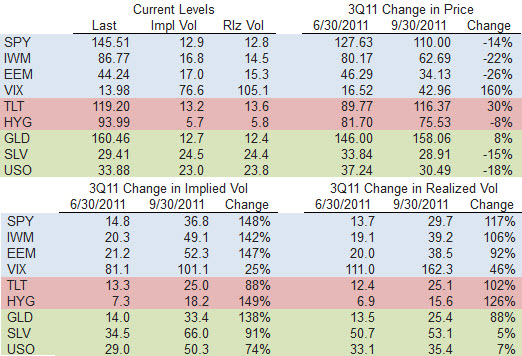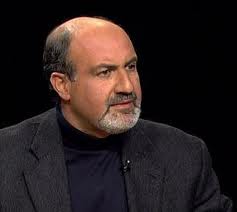|
Feb. 19 (Bloomberg)
Nassim Nicholas Taleb, Distinguished Scientific Advisor for Universa Investments LP, New York University professor and author of "The Black Swan" and "Antifragile: Things That Gain From Disorder," talks about financial markets, the banking industry and fiscal policy. He speaks with Erik Schatzker and Sara Eisen on Bloomberg Television's "Market Makers." Click here to watch Source: Zerohedge
It is perhaps no surprise that VIX has dropped to new six year lows today as the volatility of the underlying equity market has now been repressed to its lowest point is 17 years. Not since 1996 has short-term realized volatility been this low. The premium (between implied and realized volatility) continues to compress as options traders scalp the difference but increasingly that trade will feel like those nickels just ain't worth the impending steam-roller's wrath. As we noted last night, implied vol skews are as complacent to any downside risk as they have been since before the crisis was even being considered. Source – Global investment bank Jefferies One of the largest potential volatility events for the equity markets this year will be the Q1 US Debtapalooza. There are three main issues that are to be debated with a crescendo coming in late February – the Long Term Budget Deal, the 2013 Budget Deal and the Debt Limit. There will obviously be many consequential threats and theatrics associated with these events – including potential threats for government shutdowns and debt defaults – while the very real consequences could be additional US ratings downgrades. It is important to remember that outside of the 2008 shock, the Debt Ceiling Debate and consequent US Debt Downgrade in Summer 2011 created the biggest volatility event of the past two decades. S&P 500 Realized 15-Day Vol - August 2011 was a massive event: Volatility metrics show that the market is extremely complacent heading into these events. Equity volatility and skew [volatility across strike prices] are trading near multi-year lows (5th percentile or less over past two years), while many market indices are making new multi-year highs. From a positioning standpoint, net exposures are higher than any time in 2012 while hedges are at multi-year lows. Total S&P500 Put Open Interest has fallen from 9.5mm contracts to 5.7mm contracts in the past month – This is the lowest level of puts outstanding for the S&P500 since June 2009. The bottom-line is that we are heading into a potential multiple-standard deviation volatility event with the price of options at their lows and market exposures/equity prices at their highs. 3Q11 changes in price, front month put implied volatility, and 90-day realized volatility across asset classes: Hat-tip Zerohedge
Elliott Management is not only one of the largest hedge funds in the US managing over $20 billion but certainly one of the oldest having launched in 1977. Singer's tracked record for this 35 year period is exceptional. Here below an excerpt from their latest monthly letter.
Money Tsunami The concept of “money” used to be simple: items of recognized value, initially in the form of shells, livestock, and then precious metals. At some point, someone decided to print currency on paper, but it was widely understood that it had to be backed by something real, like gold or silver. That history is oversimplified, but it illustrates this central truth: Money that is created at will, rather than grown in the field, mined from the earth, or otherwise subject to supply limitations, can be easily degraded. Nobody would want to own something that may or may not have value and purchasing power in the future. What, then, determines the value of money? The worldview and ethics of those in charge of the printing presses are obvious answers that are often overlooked. Another is the confidence (or inertia!) of the people who hold and trade the money, or claims denominated in money. Fast forward to the modern era, which features central banks, so-called “fractional reserve banking,” leverage, and derivatives. Central banks allowed commercial banks to create money by making loans while keeping small amounts of reserves on hand or at the central banks. As money market funds, bank CDs, and other like instruments were created and then became a sizeable portion of the global financial system, things got even more complicated. An obvious clue that the very definition of money, to say nothing of the appropriate ways to analyze and adjust monetary policy, have departed from the understanding and control of monetary authorities can be found in the proliferation over time of acronyms to describe what used to be called simply “the money supply”: M1, M2, M2A, M3, MZM, and several others. Add modern derivatives, which entered the scene in a significant way only some 30 years ago, and the picture becomes even murkier. To demonstrate this, in slow motion, consider the creation of a credit default swap (CDS), and then a mortgage collateralized debt obligation (CDO). Assume an investor wants to be long the credit of IBM. The investor offers to sell to a dealer a CDS on IBM. The dealer purchases the CDS and either keeps it or lays off the risk by booking an offsetting transaction with someone else. Actual securities issued by IBM are not part of these transactions – the CDS is just a contract between the investor and the dealer. As IBM’s credit quality is perceived to change, the price of the CDS will fluctuate and money will change hands between the investor and the dealer (based on the “mark to market”). This position is basically a borrowing by the investor who now “owns” a security referencing the credit of IBM, and who has put up only a small deposit – a tiny fraction of the notional credit exposure that the investor is long. It also represents a highly-leveraged loan by the dealer. Although the investor/borrower does not receive the full proceeds of this “loan,” he or she bears the full risk of loss on the underlying asset. It is as if the investor borrowed money from the dealer, added a small amount of his or her own money, and purchased an IBM security with the total amount of money. Interestingly, such borrowings also have the effect of impacting the price of the actual underlying assets (in this case, IBM credit) due to arbitrage pressures. In effect, these transactions by investors and non-bank dealers represent many of the characteristics of the creation and dissipation of money, but they are outside the traditional and commonly-understood mechanics of fractional reserve banking. Most economists would not consider these transactions in the context of money supply, but we think that they are being mechanistic and not seeing the actual effects of the basically unlimited ability of private derivatives transactions to have many of the same effects as are caused by the creation and destruction of “money.” The ecosystem of mortgage securitizations has similar characteristics. It starts with the tranching of pools of mortgages into mortgage-backed securities (MBS) and then the referencing (via derivatives) of low-rated tranches to form new securities called synthetic CDOs. Based upon fanciful assumptions about diversity that prevailed pre-2008, the bulk of synthetic CDOs that referenced low-rated mortgage-pool tranches magically turned into AAA-rated securities. These instruments, even in subprime mortgage securitizations, were consequently treated by regulators as zero-risk-rated. Until the music stopped, these high-rated securities had many of the powerful multiplier effects of money. Furthermore, the institutions that packaged and sold the MBS, and those that put together the synthetic CDOs, performed many of the functions of banks (conjuring credit out of small reserves) even if they weren’t banks. Finally, the entire process caused demand for houses to increase and prices to rise. The purpose of this part of the discussion about money is to show that things have gotten really complex and subtle in the modern banking and derivatives era, and that the old model of money as being solely or mainly the product of bank reserves and bank loans is woefully inadequate. Now one more element should be added to this mix: quantitative easing, or QE. The government spends money on roads, bureaucrats’ salaries, entitlements, etc. To pay for such spending, Treasury sells a security to the public, and it has an obligation to repay the purchaser when the security matures. The security might be a Treasury Bill, a 30-year bond, or anything in between. The Federal Reserve (or the Fed, as it is commonly known) has the ability to set short-term interest rates, which has incentive/disincentive effects on bank lending and consumer spending. In a nutshell, that model has prevailed as the status quo since the Fed was created in 1913, up until 2008. Since the crash of 2008, there has been an additional dynamic at work. Namely, the Fed is purchasing massive amounts of Treasury securities, either directly or on the open market. To be clear, the cash outlays by Treasury for government spending are the same as in the preceding paragraph. The difference is that post-crash, there are far fewer securities outstanding that the Treasury must pay off at maturity, because trillions of dollars of such securities are owned by another department of the federal government. We think this process is the effective equivalent of money-printing. For those who think otherwise, we pose the following question: If QE did not have the effect of printing money, why would the Fed do it? We do not think that QE is merely a duration swap. If the government simply wanted shorter duration and cheaper borrowing costs, the easy course would be for the Fed to set interest rates at zero and for the Treasury to issue only 30-day Treasury Bills to pay for government spending. One possible outcome of such an approach would be that the price of long-term bonds would be uncontrolled, and could possibly fall precipitously, thereby driving up long-term interest rates. Instead, the government adopted a zero interest rate policy, or ZIRP, and Treasury’s borrowing rates dropped as the Fed purchased its bonds, elevating the prices of virtually all other securities. All of this contrivance is intended to be an indirect way of supporting economic activity, and perhaps it has done that to some degree. But it is causing massive distortions of risk-reward in stocks and bonds, as well as significant expansion of future risks of both inflation and severe losses in asset prices. These losses would be experienced by both the Fed and by investors. The Fed’s explanations of these policies are delivered with equanimity and aplomb. However, in our view, the inventions of modern finance have “gotten away from them” and are not adequately understood by the money-printing overseers. A “smoking gun” is the complete failure of policymakers (and financial-institution executives) to predict or understand the circumstances surrounding the 2008 financial crisis – neither the inner workings/interconnectedness of the institutions involved nor the risks inherent in the system. Recently released minutes of Fed meetings in 2007 make it clear that they did not understand the modern financial system: its structure, the instruments that comprised it, the implications of the leverage and risk-taking afforded by untested derivative products, and the vulnerability and opacity of the major financial institutions. It does not mean that the Fed has no credibility when it acts or makes pronouncements today. But it certainly means that they should not have a great deal of presumptive credibility, especially about elements that are experimental and untested or that they got so wrong recently (like QE, and the risks of a system comprised of modern highly-leveraged financial institutions laden with derivatives positions, respectively). It is critically important for investors to try to understand what global QE is actually doing, where it may lead, and what will happen when it slows, stops or shifts into reverse. What we urge most strongly is that the current atmosphere of calm and stability, and the lack of virulent inflation, must not be relied upon to continue forever. There are certain words and phrases in official communications that give some hint of the uncertainty that exists about key elements of central-bank policies: confidence, anchored inflationary expectations, and velocity are prime examples. Our takeaway is that when investors lose confidence in ZIRP-soaked, QE-ridden, faith-based paper money, the consequences could be abrupt and catastrophic to societal stability. We do not know exactly what to do about it, except to urge policymakers to STOP substituting QE for sound tax, regulatory, labor, environmental, and fiscal policies. Due to the combination of the lagged nature of inflation in wages and consumer prices, the vital (if possibly more ephemeral than policymakers think) role of “confidence,” and the fact that each particular brand of paper money is competing with other currencies that are similarly mismanaged, the world is in a position today in which the major central banks see only the beneficial effects of QE and not the risks. Bonds that otherwise might be collapsing and repudiated are at sky-high prices with stingy yields. Reported consumer inflation is near historic lows. Consequently, central bankers think that what they got away with yesterday will also work today and next week. Investors either have not figured out that they are long seriously overpriced promises or think that they will all have the luck and perspicacity to reject such instruments before they plunge in price. The reason we combined derivatives and QE in this discussion is that both are proud inventions of modern financial science, both have many of the characteristics of money-creation, and both are undertaken without any real understanding by public or private sector leaders of their nature, power, interconnectivity, and ultimate consequences. QE is exceptionally dangerous and way past its tipping point. We do not believe it can be unwound without serious consequences. Central bankers think (hope?) that it can be easily unwound at some future date, but they may not be right. When the rejection of long-term bonds and paper money starts at some unpredictable future time, it may be fast and difficult to contain or reverse. History is replete with examples of societies whose downfalls were related to or caused by the destruction of money. The end of this phase of global financial history will likely erupt suddenly. It will take almost everyone by surprise, and then it may grind a great deal of capital and societal cohesion into dust and pain. We wish more global leaders understood the value of sound economic policy, the necessity of sound money, and the difference between governmental actions that enable growth and economic stability and those that risk abject ruin. Unfortunately, it appears that few leaders do. Source: Zerohedge |
A source of news, research and other information that we consider informative to investors within the context of tail hedging.
The RSS Feed allows you to automatically receive entries
Archives
June 2022
All content © 2011 Lionscrest Advisors Ltd. Images and content cannot be used or reproduced without express written permission. All rights reserved.
Please see important disclosures about this website by clicking here. |






 RSS Feed
RSS Feed